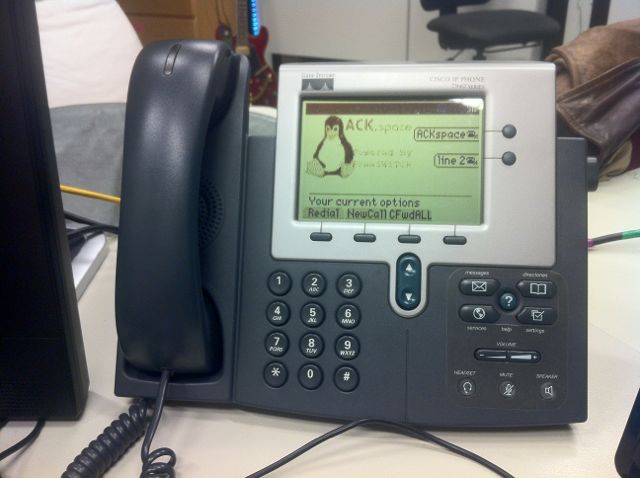Difference between revisions of "Cisco 79xx"
(added RJ12 6P6C info) |
(→current dialplan) |
||
| Line 9: | Line 9: | ||
=== current dialplan === | === current dialplan === | ||
| − | The current dialplan is set up so that you can directly dial external numbers (if we have pre-paid credit), and dial internal service numbers and extensions | + | The current dialplan is set up so that you can directly dial external numbers (if we have pre-paid credit), and dial internal service numbers and extensions. |
| + | Additional entries are needed for star(*) services which requires the user to postfix with a pound(#) sign. | ||
<pre> | <pre> | ||
<DIALTEMPLATE> | <DIALTEMPLATE> | ||
| Line 41: | Line 42: | ||
</DIALTEMPLATE> | </DIALTEMPLATE> | ||
</pre> | </pre> | ||
| − | |||
=== Phones === | === Phones === | ||
Revision as of 22:31, 29 January 2012
Contents
information
Here is some various information of the Cisco IP 7900 series phones and extension modules Currently, there are only two 7940 in the space, both with line 2 configured as an auto-answer intercom.
Note: extra information on the 7905/7910 phones and 7914 extension is on the way.
current dialplan
The current dialplan is set up so that you can directly dial external numbers (if we have pre-paid credit), and dial internal service numbers and extensions. Additional entries are needed for star(*) services which requires the user to postfix with a pound(#) sign.
<DIALTEMPLATE>
<TEMPLATE MATCH="\*..#" Timeout="0" User="Phone"/> <!-- 2 digit activate -->
<TEMPLATE MATCH="\**#" Timeout="3" User="Phone"/> <!-- 2 digit activate param -->
<TEMPLATE MATCH="\*...#" Timeout="0" User="Phone"/> <!-- 3 digit activate -->
<TEMPLATE MATCH="\**#" Timeout="3" User="Phone"/> <!-- 3 digit activate param -->
<TEMPLATE MATCH="\*..#" Timeout="0" User="Phone"/> <!-- 2 digit activate -->
<TEMPLATE MATCH="\*#..#" Timeout="0" User="Phone"/> <!-- 2 digit status -->
<TEMPLATE MATCH="\*#...#" Timeout="0" User="Phone"/> <!-- 3 digit status -->
<TEMPLATE MATCH="#..#" Timeout="0" User="Phone"/> <!-- 2 digit cancel -->
<TEMPLATE MATCH="#...#" Timeout="0" User="Phone"/> <!-- 3 digit cancel -->
<TEMPLATE MATCH="00*" Timeout="6" User="Phone"/> <!-- International calls-->
<TEMPLATE MATCH="0........." Timeout="1" User="Phone"/> <!-- National calls -->
<TEMPLATE MATCH="10.." Timeout="0" User="Phone"/> <!-- Local extensions -->
<TEMPLATE MATCH="12.." Timeout="0" User="Phone"/> <!-- Customer service -->
<TEMPLATE MATCH="13.." Timeout="0" User="Phone"/> <!-- Services -->
<TEMPLATE MATCH="131.........." Timeout="1" User="Phone"/> <!-- Services -->
<TEMPLATE MATCH="#31#.........." Timeout="1" User="Phone"/> <!-- Services -->
<TEMPLATE MATCH="\*31\*.........." Timeout="1" User="Phone"/> <!-- Services -->
<TEMPLATE MATCH="132.........." Timeout="1" User="Phone"/> <!-- Services -->
<TEMPLATE MATCH="\*10.." Timeout="0" User="Phone"/> <!-- Intercom -->
<TEMPLATE MATCH="\*19.." Timeout="0" User="Phone"/> <!-- Intercom -->
<TEMPLATE MATCH="19.." Timeout="0" User="Phone"/> <!-- Remote extensions -->
<TEMPLATE MATCH="2222" Timeout="0" User="Phone"/> <!-- Emergency -->
<TEMPLATE MATCH="4444" Timeout="0" User="Phone"/> <!-- Emergency -->
<TEMPLATE MATCH="112" Timeout="0" User="Phone"/> <!-- Emergency -->
<TEMPLATE MATCH="911" Timeout="0" User="Phone"/> <!-- Emergency -->
<TEMPLATE MATCH="999" Timeout="0" User="Phone"/> <!-- Emergency -->
<TEMPLATE MATCH="*" Timeout="4" User="Phone"/> <!-- All Other -->
</DIALTEMPLATE>
Phones
**# (sccp) settings, 9, <password> (sip)
Reboot/reload phone
**#** (sccp: reload/hot boot) *+6+settings (sip: lukewarm boot) pull the power or 'power over ethernet' plug and wait a second
Do a factory default
Note: couldn't get it to work on 7905 and 7910, only 7940(G) and 7960G
- press and hold # while cold booting (before or when the green headset lights)
- release # after the red mute lights and dims
- phone says 'Reset key sequence detected' or the like
- type 123456789*0#
- save config: 1=yes, 2=no (choose 2 to clear everything)
Power over Ethernet (PoE)
This part gives some quick information on converting/applying 802.3af PoE for usage on the 79x0 series pre-standard PoE PDs.
(needs verification) swap blue and brown, and for those pairs: swap color and white
For a type B PSE uses the spare pairs (4,5 and 7,8) with being 802.3af: undetermined polarity. Test power by placing a 25kohm resistor between pins 4 and 7. Now, make sure the pins 4 and 5 contain the positive (+48) voltage, while pins 7 and 8 have the negative (GND) voltage. You might need to swap pairs 4+5 with 7+8 (blue with brown) TODO: not sure if the resistor is needed after testing; maybe it's needed to swap the colors per pair
For a type A PSE (like NetGear FS108P), make sure the switch supports auto-sensing MDI/MDIX Test power by placing a 25kohm resistor between pins 1 and 3. Grab a crossover cable and make sure the voltage polarity is correct.
TODO: maybe build an PoE tester
source: http://www.voip-info.org/wiki/view/Cisco+POE
various
Tested all Cisco equipment with an old unregulated printer power supply of 30V= (measured 39.6V). 18V unregulated (24.6V measured) does not power them at all.
7910
- 7910 phones only work with the sccp firmware
- the 6 softkeys start at button position 5 in the FS config
all phones
- To make sure sip firmware loaded phones work across the double-NAT openVPN tunnel setup, apply the following settings (either via the config file or the unlocked menu):
- Register Expires = 100 (shorter than Linux' UDP 'establised' state time, which is 120 seconds)
- Outbound proxy = same as Proxy (not sure)
- NAT enabled = yes
- NAT address = 10.0.50.13
all this causes the extension to register with contact: "user" <sip:10xx@10.0.50.13:xxxx> and enables receiving calls
- sccp firmware loaded phones have issues with RTP audio over the double-NAT openVPN tunnel setup (signaling works).
The only way tested to work is to have a local FreeSWITCH box handling the phone traffic.
7914
- 7914 expansion panels only work with sccp firmware loaded phones
- the data cable is a 1:1 RJ12 connection with the first unit being powered by the phone (second is yet unknown)
- the RS232/AUX RJ12 pinout (pin 1 is leftmost) (pinout needs verification):
- +48V in (phone: +48v out)
- RxD (phone: TxD)
- signal ground
- TxD (phone: RxD)
- unknown/NC
- power ground
- tested with 7940: the buttons on the extension board start with button position 3 in the FS config
